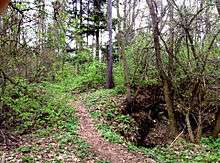Bludov Castle
Bludov Castle (Czech: Bludovský hrad) is now ruined former mediaeval fortification, one of the oldest in northern Moravia. It is situated on the top of hill called Na Starém zámku (460 m a.s.l.), around 1 km north from the town Bludov and roughly 2 km west from the town Šumperk, Olomouc Region, Czech Republic. Remains of masonry, ditches and ramparts have been protected since 1958 as the cultural monument.[1]

History
The castle was allegedly founded in the first half of the 13th century by Knight Blud of Bludov but, more likely, by his descendant Blud III (1238–88) – the predecessors of the Counts of Žerotín. Yet, the oldest documented owners of the castle were the Lords of Lipá, a powerful noble family from Bohemia. In 1346 Bludov obtained Lord Čeněk of Lipá, Highest Marshal (nejvyšší maršálek) of Bohemia and Moravia. The Lords of Lipá didn't resided in the castle but bestowed it, together with the surrounding estate, to lower nobles (knights) as the fief.
Indebted Lord Čeněk of Lipá was forced to sell the castle in 1352 to John Henry, Margrave of Moravia. After his death (1375), Bludov was inherited by his son, Margrave Prokop. During the period of possession of the castle by the margraves an extensive enlargement was done. The moat was extended around the whole castle and surrounded by a rampart. The inner castle was provided with a ward in the south-eastern part where was also newly situated main gate. On the northern side a vast fortification of the forecourt was built, surrounded by a moat with forward circular earthwork. On the northern and southern sides were erected fortifications to protect the castle from bombarding from the higher neighbouring hill. On the southern side were erected two forward log cabins (named Trhovice and Bašta), which shielded the castle from attacking and shelling from the south.
At the turn of the 14th and 15th centuries the castle was often pawned, since 1397 it fell to the Lords of Kunštát (the predecessors of the House of Podiebrad). Smil of Kunštát used the castle as the base for raids into the surrounding area. Just at the beginning of the Hussite Revolution the castle passed in 1420 to royal hands (King Sigismund of Luxembourg held it until 1436). After the mid-15th century the castle was acquired by Moravian aristocratic family of Tunklové of Brníčko. Jiří Tunkl of Brníčko the Older was loyal to Hussite "heretic" King George of Poděbrady, for which reason his castles (including the Bludov in 1471) and estates were conquered and destroyed by the Hungarian royal army under the command of King Matthias Corvinus during the Bohemian–Hungarian War.
When the Bludov estate was later (in 1494) sold to the Žerotín family, the castle was mentioned as already abandoned and ruined. During the following centuries the premises were gradually dismantled for building material; in the 19th century last remnants were used as a building material for newly paved road from Bludov to Šumperk, so just few structural elements like cellars and moats have been preserved until today.
See also
Notes
- In the Central List of Cultural Monuments of the Czech Republic (Ústřední seznam kulturních památek České republiky) the place is listed under cat. number 1000130414
References
- Plaček, Miroslav, ed. (1999). "Bludov". Hrady a zámky na Moravě a ve Slezsku (in Czech) (2nd ed.). Prague: Libri. pp. 85–86. ISBN 80-85983-72-9.
- Plaček, Miroslav, ed. (2007). "Bludov". Ilustrovaná encyklopedie moravských hradů, hrádků a tvrzí (in Czech) (2nd ed.). Prague: Libri. pp. 104–105. ISBN 978-80-7277-338-1.
External links
- Březina, Vladimír (November 9, 2005). "Bludovský hrad" [Bludov Castle]. Obec Bludov (in Czech). Retrieved December 26, 2017.